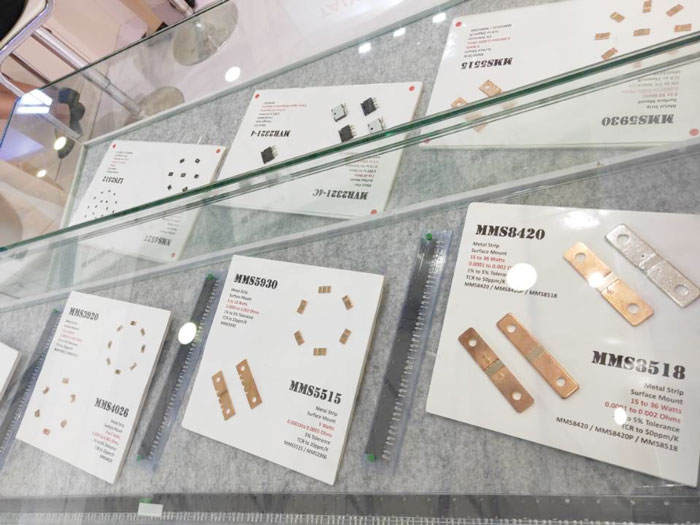Position:Home » Technical Articles
Metal Current Sense Resistors' Resistance Measurement
Writer:Microhm Page View:Date:2019-05-31
Microhm metal current sense resistors are popular devices used to measure current flow.Resistance value measurement tests typically use standard multimeters with two measuring wires. This measurement method is suitable for resistance values higher than 10 ohms, but is more prone to inaccurate results when measuring lower resistance values. This is especially true of current sense resistors with resistance values under 100 milliohms. Measuring resistance values less than 1 ohm requires the tester to apply a four-wire (Kelvin) measurement method so as to eliminate inaccuracies caused by the resistance of the measuring wires. By using a four-wire connection, the test current is forced through the component under test via a pair of wires while the voltage drop across the subject component is measured through another pair of cables.
Since the voltmeter internal resistance trends to infinite, the measuring current is very small, typically 10 to 100 pA. Thus, the voltage drop on the current sense wire is very low compared to the voltage drop on the subject component forced by the main current. This is the reason that the resistance of the current sense wire has no significant influence on the measuring result. Another advantage of using the four-wire method to measure resistance, is that it also helps to prevent the influence of any damaged wires or probes on the resistance measurement. Microhm's 4 terminal connection resistors include high precision power resistor MVR2321-4, MVR3825-4,MVR4618-4, shunt resistors and more.

While two-wire method are suitable for measuring resistance vaules greater than 10 ohms as the resistance value being measured is much higher than the typical resistance of the measuring wire.
Most digital multimeters will use a two-wire method to measure resistance. The disadvantage of this method is that not only the resistance of the component but also the total resistance of the circuit is measured. This method provides the total resistance of the measuring cables, connectors, fixtures and clips and is typically 5 to 100 milliohms, which is incorrectly added to the
measured result.

This method is also sensitive to contact probe failure or cable failure, and will introduce additional errors if those problems exist. The measurement of lower resistance values under 10 ohms using this method likely will be inaccurate, especially for metal strip current sense resistors with resistance ranges of 50 micro ohms to 100 milliohms.
Since the voltmeter internal resistance trends to infinite, the measuring current is very small, typically 10 to 100 pA. Thus, the voltage drop on the current sense wire is very low compared to the voltage drop on the subject component forced by the main current. This is the reason that the resistance of the current sense wire has no significant influence on the measuring result. Another advantage of using the four-wire method to measure resistance, is that it also helps to prevent the influence of any damaged wires or probes on the resistance measurement. Microhm's 4 terminal connection resistors include high precision power resistor MVR2321-4, MVR3825-4,MVR4618-4, shunt resistors and more.

While two-wire method are suitable for measuring resistance vaules greater than 10 ohms as the resistance value being measured is much higher than the typical resistance of the measuring wire.
Most digital multimeters will use a two-wire method to measure resistance. The disadvantage of this method is that not only the resistance of the component but also the total resistance of the circuit is measured. This method provides the total resistance of the measuring cables, connectors, fixtures and clips and is typically 5 to 100 milliohms, which is incorrectly added to the
measured result.

This method is also sensitive to contact probe failure or cable failure, and will introduce additional errors if those problems exist. The measurement of lower resistance values under 10 ohms using this method likely will be inaccurate, especially for metal strip current sense resistors with resistance ranges of 50 micro ohms to 100 milliohms.
Latest News
- Resistor's role in measuring and correcting LED,,,
- Single through-hole resistors' characteristics ,,,
- Why shunt resistors for current sense applicati,,,
- Metal-film resistors with small size, high resi,,,
- 36W High-Current Shunt Resistors MMS8420,,,
- 1W Surface Mount Resistor MPR1206,,,
- An Overview of Microhm Electronics' Resistor Pr,,,
- More anti-sulfur resistors used in harsh envir,,,
- Resistance changes with temperature,,,
- 140W TO247 High Power Heatsinkable Resistor,,,
- MMS5930 is ideal for current sensing in industr,,,
- Shunt resistors selection for engineers' design,,,
- Considerations for choosing precision resistors,,,
- Ceramic Encased Cement Resistors NWH Series for,,,
- Resistors for Passive Balancing in Battery-Pow,,,
Hot Articles
- Microhm will take part in 10th Automotive World,,,
- Thanks for Visiting Microhm's Booth E5-5706 in ,,,
- Resistors in Short Supply: Blame Cars,,,
- New lunch: High Power Precision Shunt Resistor,,,,
- How to Test a Resistor,,,
- Innovative Technology, Future Electric: Electri,,,
- What is Precision Resistors?,,,
- SMD Resistors Sizes and Packages,,,
- The Construction and Features of Metal Film Res,,,
- What is a TO-220 Resisor?,,,
- Hot Selling Products: Precision Shunt Resistors,,,
- How to Calculate the Equivalent Resistance Valu,,,
- What is a Fixed Resistor?,,,
- Resistors in LED Circuits,,,
- Resistors Types and Materials Overview,,,
Resistance applications
- Heater Blower Motor Resistor in Air Conditioner,,,
- Select the Right Resistor for Harmonic Filterin,,,
- Shunt Resistor MMS8420 for High Current Stable ,,,
- Precision Resistors' Construction and TCR,,,
- Why Zero-Ohm Resistors?,,,
- The Measurement Accuracy of Automotive Shunt is,,,
- Urbanization Development Bringing the Transform,,,
- BMS for New Energy Vehicle,,,
- Industrial Roberts Applied to Solar Photovoltai,,,
- The Four Important Functions of Alloy Resistors,,,
- Miniature future for passive electronic compone,,,
- Surface Mount Resistor's Size and Package ,,,
- Difference Between High Precision Resistors and,,,
- Carbon Film Resistors' Features and Application,,,
- The Main Application for High Precision and Low,,,
